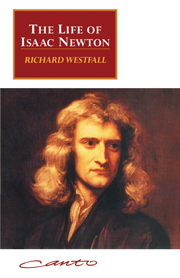Book contents
- Frontmatter
- Dedication
- Contents
- Preface
- Acknowledgments
- A Note About Dates
- Plates
- 1 A Sober, Silent, Thinking Lad
- 2 The Solitary Scholar
- 3 Anni Mirabiles
- 4 Lucasian Professor
- 5 Publication and Crisis
- 6 Rebellion
- 7 Years of Silence
- 8 Principia
- 9 Revolution
- 10 The Mint
- 11 President of the Royal Society
- 12 The Priority Dispute
- 13 Years of Decline
- Bibliographical Essay
- Index
5 - Publication and Crisis
Published online by Cambridge University Press: 05 September 2013
- Frontmatter
- Dedication
- Contents
- Preface
- Acknowledgments
- A Note About Dates
- Plates
- 1 A Sober, Silent, Thinking Lad
- 2 The Solitary Scholar
- 3 Anni Mirabiles
- 4 Lucasian Professor
- 5 Publication and Crisis
- 6 Rebellion
- 7 Years of Silence
- 8 Principia
- 9 Revolution
- 10 The Mint
- 11 President of the Royal Society
- 12 The Priority Dispute
- 13 Years of Decline
- Bibliographical Essay
- Index
Summary
THE PAPER ON COLORS that Newton sent to the Royal Society early in 1672 in the form of a letter addressed to Henry Oldenburg did not contain anything new from Newton's point of view. The occasion provided by the telescope had come at an opportune time. At Barrow's behest, Newton had been revising Barrow's lectures for publication during the winter. He had not found it a great chore to produce a succinct statement of his own theory buttressed by three prismatic experiments that he took to be most compelling. He thought it relevant to include a special discussion of how the discovery had led him to devise the reflecting telescope. The continuing correspondence provoked by the initial paper, which intruded intermittently on his time and consciousness during the following six years, also involved only one addition to his optics, his introduction to diffraction and brief investigation of it. Aside from diffraction, the entire thrust of his concern with optics during the period was the exposition of a theory already elaborated.
The continuing discussion forced Newton to clarify some issues. When he wrote in 1672, he had not yet fully separated the issue of heterogeneity from his corpuscular conception of light, and he allowed himself to assert that, because of his discovery, it could “be no longer disputed … whether Light be a Body.” He could hardly have been more mistaken. Within a week of the paper's presentation, Robert Hooke produced a critique that mistook corpuscularity for its central argument and proceeded to dispute it with some asperity.
- Type
- Chapter
- Information
- The Life of Isaac Newton , pp. 85 - 109Publisher: Cambridge University PressPrint publication year: 1994

